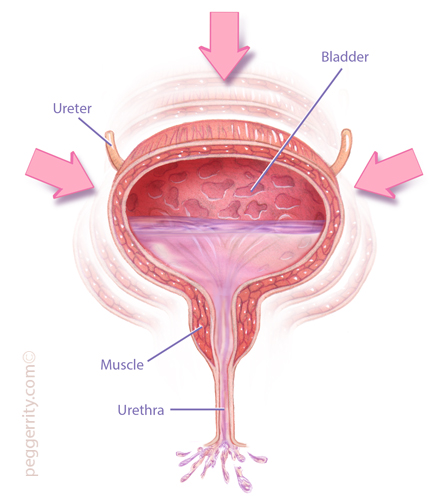Overactive Bladder (OAB) is a problem of bladder storage that results in a sudden sometimes uncontrollable urge to urinate. OAB affects 1 in 6 adults, can occur at any age, and while it is more common in older adults, Overactive Bladder it is NOT a normal consequence of aging. By definition, the cause of OAB is unknown.
Symptoms
- Urinating more than eight times per day
- Waking up more than once a night to urinate
- An overwhelming and sudden need to urinate (“gotta go, gotta,go”)
- Leakage of urine before getting to the bathroom (~50% of OAB sufferers)

Impact of Overactive Bladder
OAB adversely affects a person’s quality of life. OAB sufferers report a greater incidence of poor quality of sleep, depression, infections, skin breakdown, embarrassment, social isolation due to fear of leakage, and increased risk of falls and fractures.
Overactive Bladder is NOT a normal consequence of aging and there are effective and safe treatment options available.
Overactive Bladder affects more than 33 million people in the US and is more common than diabetes, heart disease, and arthritis. Despite the fact that 80% of OAB sufferers can be cured or improved, only one out of every twelve people affected seeks help.
Treatment
Treatment for Overactive Bladder depends greatly on an individual’s capabilities and desires.
Behavioral Therapy
Behavioral therapy improves bladder control through modification of diet and activity. It includes lifestyle changes such as weight loss, smoking cessation, moderation of fluid intake, and avoidance of certain foods and beverages which can irritate the bladder. Behavioral therapy also involves bladder retraining and pelvic floor exercises.
Pelvic Floor Rehabilitation and Biofeedback
Pelvic floor rehabilitation involves improving the strength and function of the muscles which support the bladder, urethra, and rectum. When one or more of these components become weak, the pelvic floor organs may be unable to function properly. Using a special form of training called biofeedback can help you locate the right muscles to squeeze.
Medications
Medications for OAB are classified as anticholinergic drugs. These drugs relax the bladder thereby reducing the frequency and intensity of contractions, increase bladder capacity and prevent unwanted leakage of urine (urge incontinence).
InterStim Therapy
InterStim Therapy, sometimes referred to as sacral neuromodulation therapy, is a reversible treatment option for patients who have found behavioral and pharmacological treatments ineffective or not well tolerated. InterStim Therapy uses mild electrical pulses (called electrical stimulation) to stimulate the pelvic nerves which control the muscles and organs involved with bladder (and bowel) function.
Botox
Botox, which is derived from botulinum toxin, works by interfering with nerve signals in the treated muscle, essentially paralyzing it. When injected into the muscles of the bladder, Botox stops the spasms which cause the symptoms of Overactive Bladder.
Surgery
Surgery to enlarge the bladder, called augmentation cystoplasty, can be considered when the bladder is extremely small or generates high pressure. This is major surgery with potential complications and should be attempted as a last resort. Other surgeries such as neurolysis, in which the nerves supplying the bladder are cut, are rarely performed.
Axonics Therapy
Axonics Therapy is a solution for treating symptoms of overactive bladder (including urinary urgency incontinence), bowel (fecal) incontinence and urinary retention. Learn more about Axonics Therapy.
